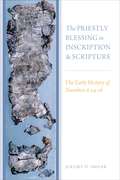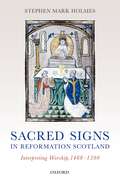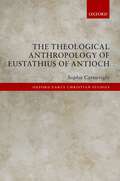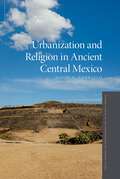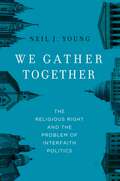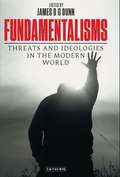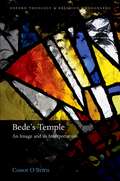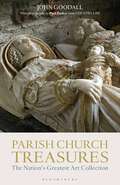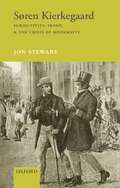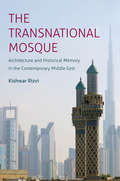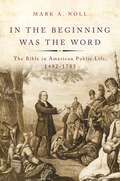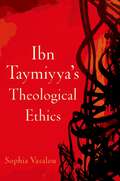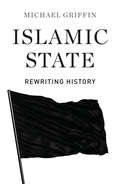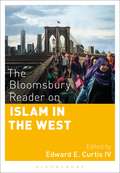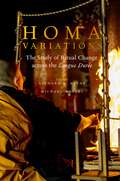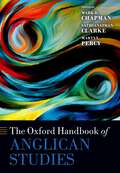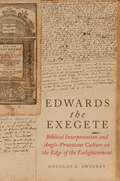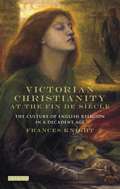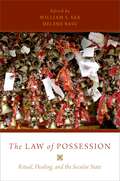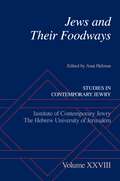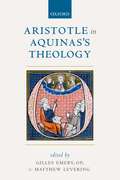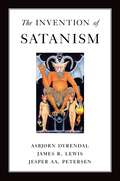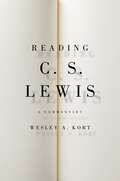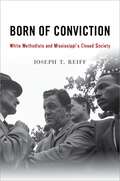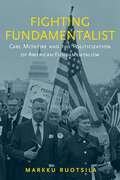- Table View
- List View
The Priestly Blessing in Inscription and Scripture: The Early History of Numbers 6:24-26
by Jeremy D. SmoakThe Priestly Blessing found in Numbers 6:24-26 left a deep imprint upon Jewish and Christian religious practice and tradition. The various ways in which the blessing was incorporated into these liturgical traditions, for example, are well documented in a variety of written sources from the past two thousand years. Rabbinic literature demonstrates that the blessing held a central place in early Jewish traditions, especially as part of the development of the Amidah and other liturgical prayers. Christian tradition also attests to a rich diversity of applications of the blessing in Byzantine and Medieval Christian practice. While the Priestly Blessing's development and significance in Judaism and early Christianity are well documented, considerably less is known about its earliest history in the ancient world. The Priestly Blessing in Inscription and Scripture breaks new ground in the study of the origins and early history of the blessing by examining its appearance on two Iron Age amulets discovered at the site of Ketef Hinnom in Jerusalem. Jeremy Smoak provides a comprehensive description of the two amulets and compares the inscriptions on their surfaces with several Phoenician and Punic inscribed amulets. He argues that the blessing's language originated within a wider tradition of protective words, which were often inscribed on metal amulets as protection against evil. He contends that the Priestly writers of the biblical texts incorporated the specific words into the blessing's formulations precisely due to their wide popularity and appeal as protective words in the eastern Mediterranean world. Smoak's argument represents an important departure from earlier studies on the background of the blessing's language in the ancient Near East, and it sheds significant new light on the history of their use within early Judaism and Christianity.
Sacred Signs in Reformation Scotland: Interpreting Worship, 1488-1590
by Stephen Mark HolmesSacred Signs in Reformation Scotland is the first study of how public worship was interpreted in Renaissance Scotland and offers a radically new way of understanding the Scottish Reformation. It first defines the history and method of 'liturgical interpretation' (using the methods of medieval Biblical exegesis to explain worship), then shows why it was central to medieval and early modern Western European religious culture. The rest of the book uses Scotland as a case study for a multidisciplinary investigation of the place of liturgical interpretation in this culture. Stephen Mark Holmes uses the methods of 'book history' to discover the place of liturgical interpretation in education, sermons and pastoral practice and also investigates its impact on material culture, especially church buildings and furnishings. A study of books and their owners reveals networks of clergy in Scotland committed to the liturgy and Catholic reform, especially the 'Aberdeen liturgists'. Holmes corrects current scholarship by showing that their influence lasted beyond 1560 and suggests that they created the distinctive religious culture of North-East Scotland (later a centre of Catholic recusancy, Episcopalianism and Jacobitism). The final two chapters investigate what happened to liturgical interpretation in Scottish religious culture after the Protestant Reformation of 1559-60, showing that while it declined in importance in Catholic circles, a Reformed Protestant version of liturgical interpretation was created and flourished which used exactly the same method to produce both an interpretation of the Reformed sacramental rites and an 'anti-commentary' on Catholic liturgy. The book demonstrates an important continuity across the Reformation divide arguing that the 'Scottish Reformation' is best seen as both Catholic and Protestant, with the reformers on both sides having more in common than they or subsequent historians have allowed.
The Theological Anthropology of Eustathius of Antioch (Oxford Early Christian Studies)
by Sophie CartwrightThis authoritative study explores Eustathius of Antioch's theological anthropology, offering insight into one of the most important thinkers of the early Arian controversy. Sophie Cartwright situates Eustathius' thought in relation to the early 'Arian' controversy, the Constaninian Revolution, the theological legacies of Irenaeus and Origen, and the philosophical commentary tradition. She also locates Eustathius within his historical context and provides a detailed overview of the sources for his complex and fragmented corpus. Eustathius' anthropology is indebted to a tradition shaped by the theology of Irenaeus, that had already come into conversation with Origen. Dr Cartwright suggests that Origen's own thought was indebted to Irenaeus but that he had a radically different cosmology; this shaped subsequent engagement with both thinkers. Eustathius' theology of embodiment draws on Irenaeus, in opposition to what he perceives as the Origenist and Platonist anthropology which, in his anti-Arian works, he associates with Eusebius of Caesarea. However, he is deeply indebted to Origen for his doctrine of Christ's human soul and, consequently, his wider psychology. He places humanity at a great distance from God and seeks to give humanity autonomous value, especially in his discourse on God's image. This represents one logical negotiation of the rejection of Origen's eternal intelligible world. Eustathius' divisive Christology offers a picture of Christ as the perfect human being that echoes Irenaeus' Adam-Christ typology, fleshed out by an Origenian discourse on Christ's human soul and infused with a keen awareness of the chasm between God and humankind. He proffers a doctrine of inherited sinfulness as an alternative to Origen's doctrine of the fall and looks to a corporeal eschatological kingdom ruled over by the human Christ; this eschatology probably reflects discomfiture with Constantine's role in the church.
Urbanization and Religion in Ancient Central Mexico (Oxford Studies in the Archaeology of Ancient States)
by David M. CarballoUrbanization and Religion in Ancient Central Mexico examines the ways in which urbanization and religion intersected in pre-Columbian central Mexico, with a primary focus on the later Formative period and the transition to the Classic period. The major societal transformations of this interval occurred approximately two-thousand years ago and over a millennium before Mexico's best known early civilization, the Aztecs. David M. Carballo presents a synthesis of data from regional archaeological projects and key sites such as Teotihuacan and Cuicuilco, while relying on his own excavations at the site of La Laguna as the central case study. A principal argument is that cities and states developed hand in hand with elements of a religious tradition of remarkable endurance and that these processes were fundamentally entangled. Prevalent religious beliefs and ritual practices created a cultural logic for urbanism, and as populations urbanized they became socially integrated and differentiated following this logic. Nevertheless, religion was used differently over time and by groups and individuals across the spectra of urbanity and social status. The book provides a materially informed history of religion, with the temporal depth that archaeology can provide, and an archaeology of cities that considers religion seriously as a generative force in societal change.
We Gather Together: The Religious Right and the Problem of Interfaith Politics
by Neil J. YoungThe story of the birth of the Religious Right is a familiar one. In the 1970s, mainly in response to Roe v. Wade, evangelicals and conservative Catholics put aside their longstanding historical prejudices and theological differences and joined forces to form a potent political movement that swept across the country. In this provocative book, Neil J. Young argues that almost none of this is true. Young offers an alternative history of the Religious Right that upends these widely-believed myths. Theology, not politics, defined the Religious Right. The rise of secularism, pluralism, and cultural relativism, Young argues, transformed the relations of America's religious denominations. The interfaith collaborations among liberal Protestants, Catholics, and Jews were met by a conservative Christian counter-force, which came together in a loosely bound, politically-minded coalition known as the Religious Right. This right-wing religious movement was made up of Mormons, conservative Catholics, and evangelicals, all of whom were united--paradoxically--by their contempt for the ecumenical approach they saw the liberal denominations taking. Led by the likes of Jerry Falwell, they deemed themselves the "pro-family" movement, and entered full-throated into political debates about abortion, school prayer, the Equal Rights Amendment, gay rights, and tax exemptions for religious schools. They would go on to form a critical new base for the Republican Party. Examining the religious history of interfaith dialogue among conservative evangelicals, Catholics, and Mormons, Young argues that the formation of the Religious Right was not some brilliant political strategy hatched on the eve of a history-altering election but rather the latest iteration of a religious debate that had gone on for decades. This path breaking book will reshape our understanding of the most important religious and political movement of the last 30 years.
Fundamentalisms: Threats and Ideologies in the Modern World
by James D. DunnWhat is fundamentalism and what does it really amount to? How do uncompromising counter-cultural movements make ordinary people behave in extraordinary ways? Arguing that an adherence to scriptural literalism and biblical inerrancy is at root a reaction to modernism, these are among the key questions with which this timely book grapples. But it goes further. Other studies have concentrated above all on Christian and Islamic fundamentalism. This volume, while exploring the origins and articulations of the fundamentalist mindset, addresses the subject from the comparative perspective of different religions, including Judaism and Hinduism. It is innovative in yet another respect. Contending that notions of certainty and infallibility are not just a religious phenomenon, the book argues that fundamentalism can be detected also in science when scientists use scientific authority to pronounce on areas outside their competence. With contributors who include Karen Armstrong, Diarmaid MacCulloch, Malise Ruthven and Ed Husain, this is a bold and incisive assessment of a crucial yet often oversimplified topic.
Bede's Temple: An Image and its Interpretation (Oxford Theology and Religion Monographs)
by Conor O'BrienThis volume examines the use of the image of the Jewish temple in the writings of the Anglo-Saxon theologian and historian, Bede (d. 735). The various Jewish holy sites described in the Bible possessed multiple different meanings for Bede and therefore this imagery provides an excellent window into his thought. Bede's Temple: An Image and its Interpretation examines Bede's use of the temple to reveal his ideas of history, the universe, Christ, the Church, and the individual Christian. Across his wide body of writings Bede presented an image of unity, whether that be the unity of Jew and gentile in the universal Church, or the unity of human and divine in the incarnate Christ, and the temple-image provided a means of understanding and celebrating that unity. Conor O'Brien argues that Bede's understanding of the temple was part of the shared spirituality and communal discourse of his monastery at Wearmouth-Jarrow, in particular as revealed in the great illuminated Bible made there: the Codex Amiatinus. Studying the temple in Bede's works reveals not just an individual genius, but a monastic community engaged actively in scriptural interpretation and religious reflection. O'Brien makes an important contribution to our understanding of early Anglo-Saxon England's most important author, the world in which he lived, and the processes that inspired his work.
Parish Church Treasures: The Nation's Greatest Art Collection
by John Goodall Paul BarkerOur parish churches constitute a living patrimony without precise European parallel. Their cultural riches are astonishing, not only for their quality and quantity, but also their diversity and interest. Fine art and architecture here combine unpredictably with the functional, the curious and the naïve, from prehistory to the present day, to form an unsung national museum which presents its contents in an everyday setting without curators or formal displays. Because church treasures usually remain in the buildings they were created for, properly interpreted they tell from thousands of local perspectives the history of the nation, its people and their changing religious observance.John Goodall's weekly series in Country Life has celebrated particular objects in or around churches that are of outstanding artistic, social or historical importance, to underline both the intrinsic interest of parish churches and the insights that they and their contents offer into English history of every period. Parish Church Treasures incorporates and significantly expands this material to tell afresh the remarkable history of the parish church. It celebrates the special character of churches as places to visit whilst providing an authoritative and up-to-date history at a time when the use and upkeep of these buildings and the care of their contents is highly contentious.
Søren Kierkegaard: Subjectivity, Irony, & the Crisis of Modernity
by Jon StewartSøren Kierkegaard: Subjectivity, Irony, and the Crisis of Modernity examines the thought of Søren Kierkegaard, a unique figure, who has freeired, provoked, fascinated, and irritated people ever since he walked the streets of Copenhagen. At the end of his life, Kierkegaard said that the only model he had for his work was the Greek philosopher Socrates. This work takes this statement as its point of departure. Jon Stewart explores what Kierkegaard meant by this and to show how different aspects of his writing and argumentative strategy can be traced back to Socrates. The main focus is The Concept of Irony, which is a key text at the beginning of Kierkegaard's literary career. Although it was an early work, it nevertheless played a determining role in his later development and writings. Indeed, it can be said that it laid the groundwork for much of what would appear in his later famous books such as Either/Or and Fear and Trembling.
The Transnational Mosque: Architecture and Historical Memory in the Contemporary Middle East (Islamic Civilization and Muslim Networks)
by Kishwar RizviKishwar Rizvi, drawing on the multifaceted history of the Middle East, offers a richly illustrated analysis of the role of transnational mosques in the construction of contemporary Muslim identity. As Rizvi explains, transnational mosques are structures built through the support of both government sponsorship, whether in the home country or abroad, and diverse transnational networks. By concentrating on mosques--especially those built at the turn of the twenty-first century--as the epitome of Islamic architecture, Rizvi elucidates their significance as sites for both the validation of religious praxis and the construction of national and religious ideologies.Rizvi delineates the transnational religious, political, economic, and architectural networks supporting mosques in Saudi Arabia, Iran, Turkey, and the United Arab Emirates, as well as in countries within their spheres of influence, such as Pakistan, Syria, and Turkmenistan. She discerns how the buildings feature architectural designs that traverse geographic and temporal distances, gesturing to far-flung places and times for inspiration. Digging deeper, however, Rizvi reveals significant diversity among the mosques--whether in a Wahabi-Sunni kingdom, a Shi&8219;i theocratic government, or a republic balancing secularism and moderate Islam--that repudiates representations of Islam as a monolith. Mosques reveal alliances and contests for influence among multinational corporations, nations, and communities of belief, Rizvi shows, and her work demonstrates how the built environment is a critical resource for understanding culture and politics in the contemporary Middle East and the Islamic world.
In the Beginning Was the Word: The Bible in American Public Life, 1492-1783
by Mark A. NollIn the beginning of American history, the Word was in Spanish, Latin, and native languages like Nahuatal. But while Spanish and Catholic Christianity reached the New World in 1492, it was only with settlements in the seventeenth century that English-language Bibles and Protestant Christendom arrived. The Puritans brought with them intense devotion to Scripture, as well as their ideal of Christendom -- a civilization characterized by a thorough intermingling of the Bible with everything else. That ideal began this country's journey from the Puritan's City on a Hill to the Bible-quoting country the U.S. is today. In the Beginning Was the Word shows how important the Bible remained, even as that Puritan ideal changed considerably through the early stages of American history. Author Mark Noll shows how seventeenth-century Americans received conflicting models of scriptural authority from Europe: the Bible under Christendom (high Anglicanism), the Bible over Christendom (moderate Puritanism), and the Bible against Christendom (Anabaptists, enthusiasts, Quakers). In the eighteenth century, the colonists turned increasingly to the Bible against Christendom, a stance that fueled the Revolution against Anglican Britain and prepared the way for a new country founded on the separation of church and state. One of the foremost scholars of American Christianity, Mark Noll brings a wealth of research and wisdom to In the Beginning Was the Word, providing a sweeping, engaging, and insightful survey of the relationship between the Bible and public issues from the beginning of European settlement. A seminal new work from a world-class scholar, this book offers a fresh account of the contested, sometimes ambiguous, but definite biblical roots of American history.
Ibn Taymiyya's Theological Ethics
by Sophia VasalouIcon of modern-day fundamentalist movements, firebrand religious purist, tireless polemicist against the intellectual schools of his time-the Ibn Taymiyya we know is a thinker we often associate with hard attitudes and dogmatic stances. Yet there is another Ibn Taymiyya that stands out from the pages of his work, the thinker who fashions himself as a master of the via media and as a defender of the harmony between human reason and the religious faith. The aim of this book is to shed fresh light on Ibn Taymiyya's intellectual identity by a close investigation of his ethical thought. Earlier Muslim thinkers debating ethical value had been exercised by a number of core questions. What makes actions right or wrong? How do human beings know it? And what is God's relationship to the evaluative standards discerned by the human mind? An investigation of Ibn Taymiyya's engagement with such questions has much to teach us about his intellectual program and particularly about the role of reason and the linchpin concept of human nature (fitra) within this program. It also has much to teach us about Ibn Taymiyya's relationship to the intellectual landscape of his time, bringing us up against a rich tapestry of ethical discussions unfolding within theology, philosophy and legal theory in the classical period. At the same time, a close reading of Ibn Taymiyya's ethics invites us to confront not only the content of his thought but its form, and more particularly those features of his writing that fracture our efforts to unify his thought.
Islamic State: Rewriting History
by Michael GriffinThis book takes the long-view by analysing Islamic State's beginnings in Iraq to their involvement in the Arab Spring and through to the present day.*BR**BR*The world is watching IS's advance through the Middle East. The US risks being drawn into another war in the region despite its experiences in Afghanistan and Iraq. IS are creating catastrophic waves across the region, but it is still unclear what lies behind its success. *BR**BR*Michael Griffin uncovers the nature of IS through investigating the myriad of regional players engaged in a seemingly endless power game: Saudi Arabia, Qatar, Turkey and Iraq, which have all contributed to the success of IS by supplying arms and funds. *BR**BR*He foregrounds the story of the uprising against President Assad of Syria, the role played by the Free Syrian Army, Islamist groups, Iran, Hezbollah and Russia, the chemical weapons attacks in 2013 and the House of Commons vote not to impose a no-fly zone over the country.
The Bloomsbury Reader on Islam in the West
by Edward E. CurtisFor more than a millennium, Islam has been a vital part of Western civilization. Today, however, it is sometimes assumed that Islam is a foreign element inside the West, and even that Islam and the West are doomed to be in perpetual conflict. The need for accurate, reliable scholarship on this topic has never been more urgent.The Bloomsbury Reader on Islam in the West brings together some of the most important, up-to-date scholarly writings published on this subject. The Reader explores not only the presence of Muslim religious practitioners in Europe and the Americas but also the impact of Islamic ideas and Muslims on Western politics, societies, and cultures. It is ideal for use in the university classroom, with an extensive introduction by Edward E. Curtis IV and a timeline of key events in the history of Islam in the West. A brief introduction to the author and the topic is provided at the start of each excerpt. Part 1, on the history of Islam in the West, probes the role of Muslims and the significance of Islam in medieval, early modern, and modern settings such as Islamic Spain, colonial-era Latin America, sixteenth-century France, nineteenth-century Crimea, interwar Albania, the post-World War II United States, and late twentieth-century Germany. Part 2 focuses on the contemporary West, examining debates over Muslim citizenship, the war on terrorism, anti-Muslim prejudice, and Islam and gender, while also providing readers with a concrete sense of how Muslims practise and live out Islamic ideals in their private and public lives.
Homa Variations: The Study of Ritual Change across the Longue Durée (Oxford Ritual Studies)
Found in many different religious cultures, the practice of making votive offerings into fire dates back to the earliest periods of human history. Throughout the tantric world, this kind of ritual offering practice is known as the homa. With roots in Vedic and Zoroastrian rituals, the tantric homa was formed in early medieval India. Since that time tantric Buddhist practitioners transmitted it to East and Central Asia, and more recently to Europe and the Americas. Today, Hindu forms of the homa are being practiced outside of India as well. Despite this historical and cultural range, the homa retains an identifiable unity of symbolism and ritual form. Homa Variations is the first volume to provide a series of detailed studies of a variety of homa forms. This collection of essays provides an understanding of the history of the homa from its inception up to its use in the present. The book also covers homa practice throughout a wide range of religious cultures, from India and Nepal to Tibet, China, and Japan. The theoretical focus of the collection is the study of ritual change over long periods of time, and across the boundaries of religious cultures. The identifiable unity of the homa allows for an almost unique opportunity to examine ritual change with such a broad perspective.
The Oxford Handbook of Anglican Studies (Oxford Handbooks)
The Anglican Communion is the third largest Christian denomination and claims a membership of some 80 million members in about 164 countries. Given that there are only around two hundred countries in the world, this makes the churches of the Anglican Communion the most geographically widespread denomination after Roman Catholicism. The 44 essays in this volume embrace a wide range of academic disciplines: theological; historical; demography and geography; and different aspects of culture and ethics. They are united in their discussion of what is effectively a new inter-disciplinary subject which we have termed 'Anglican Studies'. At the core of this volume is the phenomenon of 'Anglicanism' as this is expressed in different places and in a variety of ways across the world. This Handbook covers a far broader set of topics from a wider range of perspectives than has been hitherto attempted in Anglican Studies. At the same time, it doesn't impose a particular theological or historical agenda. The contributions are drawn from across the spectrum of theological views and opinions. It shows that the unsettled nature of the polity is part of its own rich history; and many will see this as a somewhat lustrous tradition. In its comprehensive coverage, this volume is a valuable contribution to Anglican Studies and helps formulate a discipline that might perhaps promote dialogue and discussion across the Anglican world.
Edwards the Exegete: Biblical Interpretation and Anglo-Protestant Culture on the Edge of the Enlightenment
by Douglas A. SweeneyScholars have long recognized that Jonathan Edwards loved the Bible, but preoccupation with his roles in Western "public" life and letters has eclipsed the significance of his biblical exegesis. In Edwards the Exegete, Douglas A. Sweeney fills this lacuna, exploring Edwards' exegesis and its significance for Christian thought and intellectual history. As Sweeney shows, throughout Edwards' life the lion's share of his time was spent wrestling with the words of holy writ. After reconstructing Edwards' lost exegetical world and describing his place within it, Sweeney summarizes his four main approaches to the Bible-canonical, Christological, redemptive-historical, and pedagogical-and analyzes his work on selected biblical themes that illustrate these four approaches, focusing on material emblematic of Edwards' larger interests as a scholar. Sweeney compares Edwards' work to that of his most frequent interlocutors and places it in the context of the history of exegesis, challenging commonly held notions about the state of Christianity in the age of the Enlightenment. Edwards the Exegete offers a novel guide to the theologian's exegetical work, clearing a path that other specialists are sure to follow. Sweeney's significant reassessment of Edwards' place in the Enlightenment makes a major contribution to Edwards studies, eighteenth-century studies, the history of exegesis, the theological interpretation of Scripture, and homiletics.
Victorian Christianity at the Fin de Siècle: The Culture of English Religion in a Decadent Age
by Frances KnightThe period known as the fin de siecle - defined in this groundbreaking book as chiefly the period between1885 and 1901 - was a fluid and unsettling epoch of optimism and pessimism, endings and beginnings, aswell as of new forms of creativity and anxiety. The end of the century has attracted much interest from scholars of literary and cultural studies, who regard it as a critical moment in the history of their disciplines; but it has been relatively ignored by religious historians. Frances Knight here sets right that neglect. She shows how late Victorian society (often said to be one of the most intensely Christian cultures the world has ever seen) reacted to the bold agendas being set by the thinkers of the fin de siecle; and how prominent Church figures during the era first identified many of the concerns that have preoccupied Christians latterly. These include an active interest in social justice and the creation of new types of communities; increasingly open discussion of the sexual exploitation of children; debates about society's 'decadence'; new ideas about the role of women; and the belief in the redemptive powers of art, pioneered by figures as diverse as P.T.Forsyth, Percy Dearmer and Samuel and Henrietta Barnett.Examining in particular the Christian world of fin de siecle London, the author offers penetrating insights intoa society in which the ritual and culture of Christianity sometimes permeated the aesthetic movement andwhere devotees of the aesthetic movement - like Walter Pater, Oscar Wilde and their disciples - often revealed a fascination with Christianity. She argues that the 'long 1890s' was a decisive decade in which various sections of Christian opinion, both on the progressive and the more conservative wings of the faith, began to express views which set the tone for attitudes which would become commonplace in the twentieth century. Victorian Christianity at the Fin de Siecle is the focussed treatment of religion and culture at the end of the nineteenth century that the field has long needed. It will be welcomed by scholars of church history, social and cultural history and the history of ideas.
The Law of Possession: Ritual, Healing, and the Secular State
Rituals combining healing with spirit possession and court-like proceedings are found around the world and throughout history. For example, a person suffers from an illness that cannot be cured, and in order to be healed he performs a ritual involving prosecution and defense, a judge and witnesses. Divine beings give evidence through human oracles, spirits possess their human victims and are exorcized, and local gods intervene to provide healing and justice. Such practices seem to be the very antithesis of modernity and many modern, secular states have systematically attempted to eliminate them. Why are such rituals largely absent from modern societies, and what happens to them when the state attempts to expunge them from their health and justice systems, or even to criminalize them? Despite the prevalence of rituals involving some or all of these elements, The Law of Possession represents the first attempt to compare and analyze them systematically. The volume brings together historical and contemporary case studies from East Asia, South Asia, and Africa, and argues that, despite consistent attempts by states to discourage, eliminate, and criminalize them, such rituals persist and even thrive because they meet widespread human needs.
Jews and Their Foodways (Studies in Contemporary Jewry)
Food is not just a physical necessity but also a composite commodity. It is part of a communication system, a nonverbal medium for expression, and a marker of special events. Bringing together contributions from fourteen historians, anthropologists, sociologists, and literary critics, Volume XXVIII of Studies in Contemporary Jewry presents various viewpoints on the subtle and intricate relations between Jews and their foodways. The ancient Jewish community ritualized and codified the sphere of food; by regulating specific and detailed culinary laws, Judaism extended and accentuated food's cultural meanings. Modern Jewry is no longer defined exclusively in religious terms, yet a decrease in the role of religion, including kashrut observance, does not necessarily entail any diminishment of the role of food. On the contrary, as shown by the essays in this volume, choices of food take on special importance when Jewish individuals and communities face the challenges of modernity. Following an introduction by Sidney Mintz and concluding with an overview by Richard Wilk, the symposium essays lead the reader from the 20th century to the 21st, across Europe, the Middle East, Africa, and North America. Through periods of war and peace, voluntary immigrations and forced deportations, want and abundance, contemporary Jews use food both for demarcating new borders in rapidly changing circumstances and for remembering a diverse heritage. Despite a tendency in traditional Jewish studies to focus on "high" culture and to marginalize "low" culture, Jews and Their Foodways demonstrates how an examination of people's eating habits helps to explain human life and its diversity through no less than the study of great events, the deeds of famous people, and the writings of distinguished rabbis.
Aristotle in Aquinas's Theology
Aristotle in Aquinas's Theology explores the role of Aristotelian concepts, principles, and themes in Thomas Aquinas's theology. Each chapter investigates the significance of Aquinas's theological reception of Aristotle in a central theological domain: the Trinity, the angels, soul and body, the Mosaic law, grace, charity, justice, contemplation and action, Christ, and the sacraments. In general, the essays focus on the Summa theologiae, but some range more widely in Aquinas's corpus. For some time, it has above all been the influence of Aristotle on Aquinas's philosophy that has been the centre of attention. Perhaps in reaction to philosophical neo-Thomism, or perhaps because this Aristotelian influence appears no longer necessary to demonstrate, the role of Aristotle in Aquinas's theology presently receives less theological attention than does Aquinas's use of other authorities (whether Scripture or particular Fathers), especially in domains outside of theological ethics. Indeed, in some theological circles the influence of Aristotle upon Aquinas's theology is no longer well understood. Readers will encounter here the great Aristotelian themes, such as act and potency, God as pure act, substance and accidents, power and generation, change and motion, fourfold causality, form and matter, hylomorphic anthropology, the structure of intellection, the relationship between knowledge and will, happiness and friendship, habits and virtues, contemplation and action, politics and justice, the best form of government, and private property and the common good. The ten essays in this book engage Aquinas's reception of Aristotle in his theology from a variety of points of view: historical, philosophical, and constructively theological.
The Invention of Satanism
by Asbjorn Dyrendal James R. Lewis Jesper Aa. PetersenSatanism is a complex phenomenon that has often been the source of controversy across social and rhetorical contexts. Some consider it the root of all evil. Others see it as a childish form of rebellion or as a misapplication of serious esoteric beliefs and practices. Still others consider it a specific religion or philosophy that serves as a form of personal and collective identity. In The Invention of Satanism, three experts explore Satanism as a contemporary movement that is in continuous dialogue with popular culture, and which provides a breeding ground for other new religious movements. By shifting the focus from mythology to meaning-making, this book examines the invention of Satanism among self-declared religious Satanists. Like all ideologists and believers, Satanists incorporate, borrow, and modify elements from other traditions; the authors investigate how traditional folklore and prior strands of occultism were synthesized by Anton LaVey in his founding of the Church of Satan and creation of the Satanic Bible. Later chapters discuss contemporary Satanist subcultures, demonstrating how Satanism continues to reinvent itself despite its brief history as an organized phenomenon. There are now numerous forms of Satanism with distinctive interpretations of what being a Satanist entails, with some of these new versions deviating more from the historical "mainstream" than others. In this fascinating account of a seemingly arcane and often-feared movement, Dyrendal, Lewis, and Petersen demonstrate that the invention of Satanism is an ongoing, ever-evolving process.
Reading C.S. Lewis: A Commentary
by Wesley A. KortFrom the unbending belief in invisible powers that animates Till We Have Faces to the depiction of Aslan's sacrifice and resurrection in The Lion, The Witch, and the Wardrobe, C. S. Lewis's writing has sparked intense debate about the presence and function of religion in his works. Today, a reader's opinion of Lewis is more often than not based on his or her perspectives on religion. In Reading C. S. Lewis, Wesley A. Kort examines Lewis's work as a whole, investigating why and at what points Lewis turns to religion-and particularly to Christianity-in order to advance his arguments. Kort moves through more than a dozen of Lewis's major books, providing a useful guide to their various elements while connecting readers to the literary contexts that influenced the works and Lewis himself. Reading C. S. Lewis examines the standing of Lewis's work, how best to approach the books, and the misunderstandings that lead to mistaken readings. The commentaries also function as free-standing essays that can be read individually and in any order. Reading C. S. Lewis: A Commentary sets a new standard for C. S. Lewis studies. A comprehensive examination of the major Lewis texts, this volume is a captivating look into the author's work from a refreshingly undogmatic point of view.
Born of Conviction: White Methodists and Mississippi's Closed Society
by Joseph T. ReiffWinner of the Mississippi Institute of Arts and Letters' Nonfiction Award The dominant narrative of the role of white citizens and the white church in Mississippi's civil rights era focuses on their intense resistance to change. The "Born of Conviction" statement, signed by twenty-eight white Methodist pastors and published in the Mississippi Methodist Advocate on January 2, 1963, offered an alternative witness to the segregationist party line. Calling for freedom of the pulpit and reminding readers of the Methodist Discipline's claim that the teachings of Jesus permit "no discrimination because of race, color, or creed," the pastors sought to speak to and for a mostly silent yet significant minority of Mississippians, and to lead white Methodists to join the conversation on the need for racial justice. The document additionally expressed support for public schools and opposition to any attempt to close them, and affirmed the signers' opposition to Communism. Though a few individuals, both laity and clergy, voiced public affirmation of "Born of Conviction," the overwhelming reaction was negative-by mid-1964, eighteen of the signers had left Mississippi, evidence of the challenges faced by whites who offered even mild dissent to massive resistance in the Deep South. Dominant narratives, however, rarely tell the whole story. The statement caused a significant crack in the public unanimity of Mississippi white resistance. Signers and their public supporters also received private messages of gratitude for their stand, and eight of the signers would remain in the Methodist ministry in Mississippi until retirement. Born of Conviction tells the story of "the Twenty-Eight" illuminating the impact on the larger culture of this attempt by white clergy to support race relations change. The book explores the theological and ethical understandings of the signers through an account of their experiences before, during, and after the statement's publication. It also offers a detailed portrait of both public and private expressions of the theology and ethics of white Mississippi Methodists in general, as revealed by their responses to the "Born of Conviction" controversy.
Fighting Fundamentalist: Carl McIntire and the Politicization of American Fundamentalism
by Markku RuotsilaFor most of his sixty-year career, the Reverend Carl McIntire was at the center of controversy. The best-known and most influential of the fundamentalist radio broadcasters and anticommunists of the Cold War era, his many enemies depicted him as a dangerous far rightist, a racist, or a "McCarthyite" opportunist engaged in red-baiting for personal profit. Despised and hounded by liberals, revered by fundamentalists, and distrusted by the center, he became a lightning rod in the early days of America's culture wars. Markku Ruotsila's Fighting Fundamentalist, the first scholarly biography of McIntire, peels off the accumulated layers of caricature and makes a case for restoring McIntire to his place as one of the most consequential religious leaders in the twentieth-century United States. Ruotsila traces McIntire's life from his early twentieth-century childhood in Oklahoma to his death in 2002. From his discipleship under J. Gresham Machen during the fundamentalist-modernist controversy, through his fifty-year pastorate in Collingswood, New Jersey, and his presidency of the International Council of Christian Churches, McIntire, Ruotsila shows, stands out as the most important fundamentalist of his time. Drawing on exhaustive research in fifty-two archival collections-including the recently opened collection of the Carl McIntire papers and never-before-seen FBI files-Ruotsila looks beyond the McIntire of legend to discover a serious theological, political, and economic combatant, a tireless organizer who pioneered the public theologies, inter-faith alliances, and political methods that would give birth to the Christian Right. The moral values agenda of the 1970s and after would not have existed, Ruotsila shows, without the anti-communist and anti-New Deal activism that McIntire inaugurated. Indeed, twentieth-century American religious and political history were profoundly shaped by forces McIntire set in motion. Fighting Fundamentalist tells the overlooked story of McIntire and the movement he inspired.
